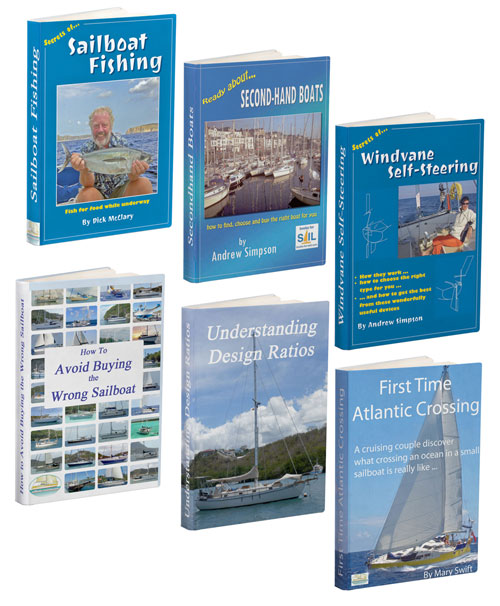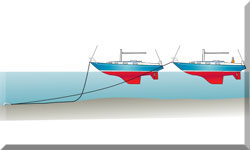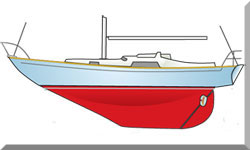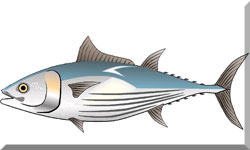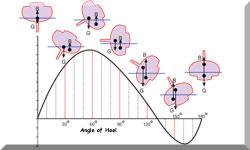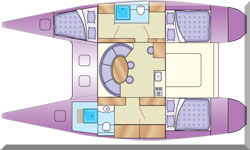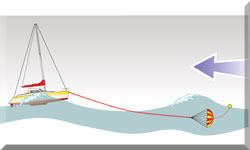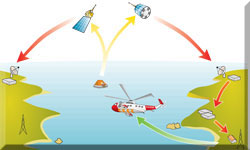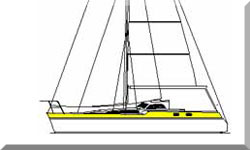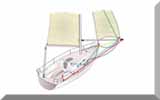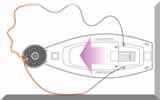Getting to Grips with Sail Trim: A Guide to Optimal Performance
In a Nutshell
Nailing your sail trim is all about finding that sweet spot between the wind, your boat, and your sails. By getting to grips with a few key concepts and listening to what your sails are telling you, you can get the best out of your boat, keep her on her feet, and make your time on the water a breeze. It's about turning your sails into a proper power-generating machine to get you where you want to go, fast and in control.
Table of Contents
- Why is sail trim so important?
- What are these "points of sail" and why should I care?
- Reading the wind: what are tell-tales?
- The ins & outs of getting your trim right
- What about the jib?
- Which sail do I trim first?
- How sail trim can fix a heavy helm
- Getting downwind: it’s a whole new ball game
- Summing Up
- Frequently Asked Questions
Why is sail trim so important?
Look, as a fellow sailor, I know it's easy to just hoist the sails and go. But trust me, sail trim is the real deal. It's the difference between slogging through the water and having your boat just fly. The main aim is to get your sails working for you, creating the perfect shape to grab all that wind and turn it into forward motion. You want to avoid overpowering the boat, which makes her heel over like she’s had a few too many and makes steering a right pain. The goal is a balanced helm that feels light and responsive.
What are these "points of sail" and why should I care?
If you're going to talk about sail trim, you've got to start with the points of sail. It's the basic framework for everything. They simply describe where your boat is headed in relation to the wind, and they dictate how you need to set your sails.
- Close-hauled: This is sailing as close as you can to the wind, maybe 30 to 45 degrees. Think of it as pinching upwind. The sails are pulled in tight, as close to the centreline as you can get them without luffing.
- Close Reach: You're off the wind a little more here. Ease those sheets just a tad.
- Beam Reach: The wind's coming from dead sideways. This is often where a lot of boats feel like they're flying.
- Broad Reach: The wind's coming from the back quarter of the boat. The sails are eased way out.
- Running: The wind is coming from right behind you. The sails are let out to catch as much wind as possible, often wing-on-wing.
Reading the wind: what are tell-tales?
This is where the magic happens. Those little bits of yarn on your sails, called tell-tales, are your best mates when it comes to getting the trim spot-on. They're like little spies, showing you how the wind is flowing over both sides of the sail. For a perfect set-up, you want both the windward and leeward tell-tales streaming smoothly back.
- If the inside one (windward) is flapping around: Your sail is too tight. Let that sheet out a bit.
- If the outside one (leeward) is jumping all over the place: Your sail is too far out. Pull that sheet in a bit.
The ins & outs of getting your trim right
Sure, the mainsheet is the one everyone knows, but there's a whole kit and caboodle of other lines and controls that help you shape your sails just so.
- Mainsheet: This is the big one. It's basically the accelerator and brake for your mainsail, controlling how far out the boom sits.
- Halyard Tension: This pulls the sail up the mast. Get it too slack and you'll see horizontal wrinkles; get it too tight and you'll put too much strain on the sail. It helps you set the sail's draft, or belly, just right.
- Outhaul: This one pulls the bottom of the sail, the foot, tight along the boom. In light wind, you want to ease it off for a nice, full sail. When it blows up, you'll need to crank it on to flatten things out and de-power.
- Boom Vang (Kicker): This keeps the boom from lifting up, especially when sailing downwind. It's a lifesaver for controlling the twist in your mainsail.
- Traveller: This moves the boom's attachment point from side to side. It's a real game-changer for getting the right angle on the sail without pulling the boom in too tight.
What about the jib?
The headsail is just as important as the main. On many boats, they work together as a team. Here’s what you need to know:
Sheet Tension: Just like the main, you use this to set the headsail’s angle. Use those tell-tales. When they're all streaming back, you're golden.
Jib Cars (Lead Position): These little gizmos on the deck let you change where the sheet pulls on the sail.
- Move the car forward: This tightens up the back edge of the sail (the leech) and makes the bottom fuller. Good for when the wind is a bit lazy.
- Move the car aft: This flattens the bottom and lets the top of the sail twist open. Perfect for when the wind's getting a bit frisky.
Halyard Tension & Forestay Sag: The tension on the halyard tightens the front edge of the sail. In light air, a little sag in the forestay can help make the sail fuller and more powerful. When the breeze is up, you want to crank it tight to flatten the sail and keep control.
Which sail do I trim first?
It's a question as old as sailing itself. When you're heading upwind, start with the mainsail. It's the engine of the boat and sets the whole feel. Once the main is set right for the conditions, then trim the headsail to match it. You're looking to create a nice, even "slot" between the two sails. This channel of wind helps the mainsail work better. It’s all about teamwork.
How sail trim can fix a heavy helm
Ever had your boat try to turn up into the wind on its own? That's what sailors call weather helm, and it's a real pain in the backside. It's like the boat is fighting you, and it's a huge drag that slows you down. It happens when the centre of effort—the main push from the sails—is too far aft.
To sort it out, you need to shift that centre of effort forward. You can:
- Flatten your sails: Use the outhaul to flatten them out.
- Ease your mainsheet or traveller: This takes power out of the main, bringing the overall push forward.
- Reef the mainsail: This is the nuclear option for when it’s really blowing. It's the most effective way to de-power the boat and get things balanced again. To learn more about this vital practice, check out our comprehensive guide, Reefing a Sail: The Ultimate Guide to Control & Safety at Sea.
On the other hand, if your boat is always trying to turn away from the wind (lee helm), your centre of effort is too far forward. You can fix that by easing your headsail or adding more power to the main. A well-trimmed boat feels like it’s sailing itself.
Getting downwind: it’s a whole new ball game
Upwind, you’re looking for lift. Downwind, you're all about catching the wind and letting it push you along. The whole strategy changes.
- Broad Reaching: Just ease out the sheets on both sails until they're full and happy. Make sure you use the boom vang to keep the boom down and the sail shape good.
- Running: This is where you might "wing out" the headsail to the other side of the boat to catch as much wind as you can. You'll often use a whisker pole to hold the headsail out so it doesn't get all floppy and hide behind the main.
- Spinnaker & Gennaker: For a proper downwind party, a spinnaker is the bee's knees. Trimming one is a continuous job, but the pay-off is immense.
Summing Up...
Getting a handle on sail trim is what separates a decent sailor from a great one. It’s a constant conversation with your boat, the wind, and the water. It’s a feeling you get—a quiet confidence in the helm that tells you everything is hunky-dory. Once you find that sweet spot, you’ll be chuffed to bits with how well your boat performs. It’s not just about speed; it's about a well-behaved boat that’s a real pleasure to sail.
This article was written by Dick McClary, RYA Yachtmaster and author of the RYA publications 'Offshore Sailing' and 'Fishing Afloat', member of The Yachting Journalists Association (YJA), and erstwhile member of the Ocean Cruising Club (OCC).
Frequently Asked Questions
How does sail trim affect the boat's handling?
How does sail trim affect the boat's handling?
Getting your sail trim right keeps the boat from heeling over too much, makes her go faster, and gets rid of a heavy weather helm. In short, it makes the boat a real joy to steer.
How often should I be tweaking my sails?
How often should I be tweaking my sails?
Sail trim is a constant give-and-take. You should be making small tweaks all the time as the wind changes or as you change your course.
What's the difference between true and apparent wind?
What's the difference between true and apparent wind?
True wind is the actual wind you'd feel if you were standing still. Apparent wind is what you actually feel on a moving boat. It's a mix of the true wind and the wind created by the boat's own motion.
What does it mean when my sails are "luffing"?
What does it mean when my sails are "luffing"?
Luffing is when a sail flaps because the wind isn't flowing smoothly over it. It's a sign that you're not getting any power and you need to either change your course or pull the sail in.
Can I trim sails on my own?
Can I trim sails on my own?
Absolutely. Plenty of boats are designed for single-handed sailing. You just need to have a bit of a system and know what you're doing to get the job done safely and efficiently.
Resources Used
- Discover Boating. Points of Sail and Directions of Sail Trim. https://www.discoverboating.com/resources/points-of-sail-and-directions-of-sail-trim
- North Sails. Cruising Sail Trim: Putting it all together. https://www.northsails.com/blogs/north-sails-blog/cruising-sail-trim-north-sails-3di-nordac
- Saltwater Journal. (2025, May 28). An Easy Guide to Points of Sail. https://www.saltwaterjournal.life/blog/points-of-sail
- Sailing Magazine. (2021, June 1). Understanding sail trim. https://sailingmagazine.net/article-2336-understanding-sail-trim.html
- Yachting Monthly. (2020, September 28). How to reef to sail safely through any weather. https://www.yachtingmonthly.com/sailing-skills/how-to-reef-to-sail-safely-through-any-weather-74194
- Cruising World. (2016, May 27). Trimming your Headsails. https://www.cruisingworld.com/trimming-your-headsails/
- Sail Magazine. (2018, July 1). A Guide to Weather Helm. https://www.sailmagazine.com/cruising/a-guide-to-weather-helm
Recent Articles
-
Planning Your Sailboat Liveaboard Lifestyle: An Ocean Sailor's Guide
Dec 06, 25 05:18 AM
Seasoned sailors share their methodical risk analysis for planning a secure Sailboat Liveaboard Lifestyle, covering financial, property, and relationship risks. -
Marine Cabin Heaters: The Expert’s Guide to Comfort & Safety at Sea
Dec 05, 25 06:52 AM
Choose the best Marine Cabin Heaters for your vessel. Expert advice on diesel, paraffin, and hot water systems for year-round cruising comfort. -
Marine Water Heating Systems: Free Hot Water from Your Boat's Engine
Dec 03, 25 05:06 PM
Tap into your engine's heat to get free hot water on board. An experienced ocean sailor's guide to marine water heating systems, calorifiers & safety.
